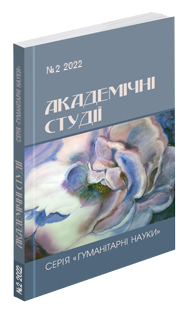Abstract
E. T. A. Hoffmann is considered the most outstanding figure in the history of German romanticism, although he was not one of the first representatives of this literary movement. His creative heritage contains the main themes and ideas of romanticism, its most important features. Romanticism appeared at the break of the era and during the French Revolution. The central theme of the new literary trend was the confrontation between man and the world, and the main conflict was the struggle between Good and Evil. Everything incomprehensible, mystical, fantastic, which is closely intertwined with reality, attracted romantics. Such works of E. T. A. Hoffmann as “The Pot of Gold”, “Little Tsaches, nicknamed Cinnabar”, “Elixirs of the Devil”, “The Sandman”, etc. are vivid examples of the new literary era. E. T. A. Hoffmann belongs to those writers whose artistic world has become a nominal concept. However, his writing talent is only one manifestation of his creative nature. During his lifetime, he was a singer, conductor, musical theater director, composer, and artist. Such a phenomenon, when artists simultaneously have talents in different areas of art, is also called Doppelbegabung (German – “double talent, ability”) in literary studies, and U. Weisstein suggests the term “multitalent” for such artists. Their thinking is synthetic, and their works acquire a polyartistic character and are vivid examples of the interaction of arts. That is why the writer's style differs from others in its musicality and plasticity. And because of this, the most appropriate analysis of E. T. A. Hoffmann's works is intermedial, which involves the organization of the text through the interaction of different types of art at the semantic level. Intermedial aesthetics arises precisely in the historical and cultural transitional eras – baroque, romanticism, modernism, postmodernism. On the other hand, E. T. A. Hoffmann's creative legacy is surprisingly cinematic. His short stories are almost ready-made scripts, full of unexpected plot twists and visual tricks. The film stylistics of E. T. A. Hoffmann's novels is manifested both in plot references and in the peculiarities of his poetics as film poetics. The literary problem “poetics of a literary work – film poetics” is one of the most important in the intermedia relations of these two arts. Its importance and relevance are determined by the awareness that absorbing, for example, a literary text as a result of the synthesis of the arts of elements of some other art means expanding and enriching one's expressive possibilities. Therefore, the approach to the literary texts of the German writer with the “cinematic code” is a promising direction in the development of the methodology for the study of the poetics of the literary text and enables a deeper understanding of the creative legacy of E. T. A. Hoffmann.
References
Гофман Е. Т. А. Володар бліх. Життєва філософія кота Мура. Харків : Фолио. 2015. 610 с.
Гофман Е. Т. А. Музичні новели / З нім. пер. Є. Попович. Київ : Муз. Україна, 1987. 248 с.
Западное литературоведение ХХ века. Энциклопедия. Москва : Intrada, 2004. 560 с.
Клер Р. Размышления о киноискусстве. Москва : Искусство, 1958. 360 с.
Лотман Ю. М. Избранные статьи в трех томах. Т. 1. Статьи по семиотике и типологии культуры. Таллинн : Александра, 1992. 480 с.
Наливайко Д. Теорія літератури й компаративістика. Київ : Вид. дім «Києво-Могилянська академія», 2006. 347 с.
Экфрасис в русской литературе : Труды Лозаннского симпозиума / под ред. Л. Геллера. Москва : Издательство “МИК”, 2002. 216 с.

